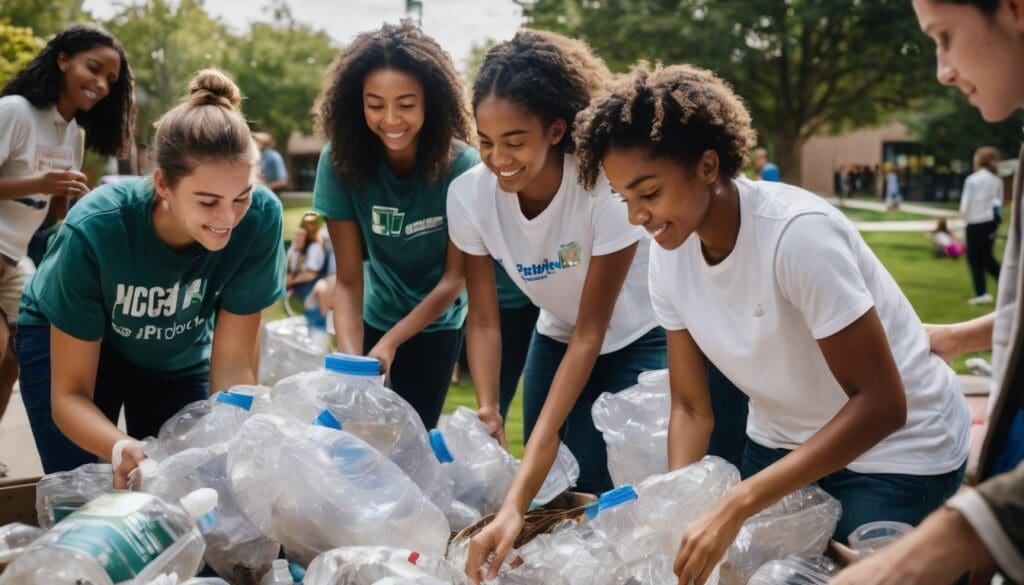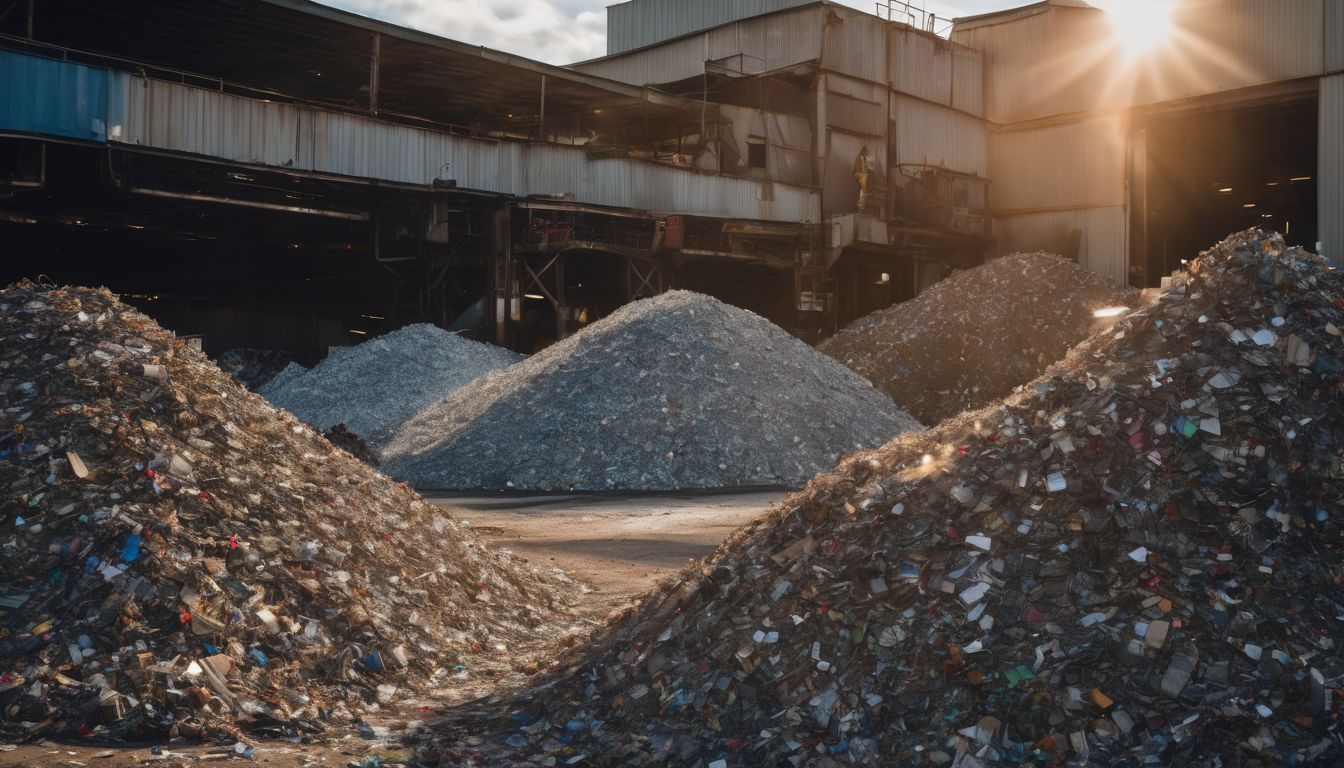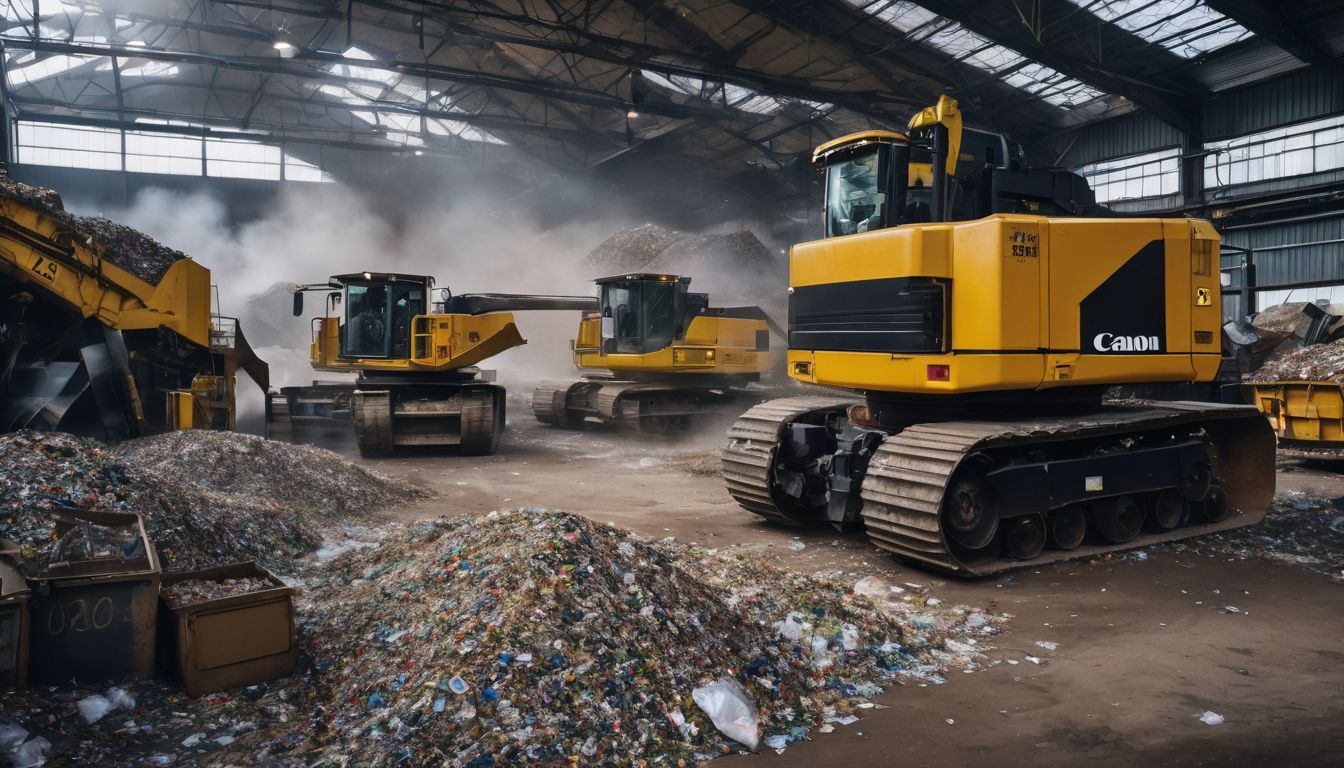Schools are bustling hubs where lots of waste can be generated every day. It’s staggering to know that an average secondary school could produce up to 22 kilograms of waste per student each academic year.
This blog will guide you through setting up efficient and impactful recycling programs in your schools, right from the grassroots level. Dive in for some planet-friendly inspiration!
Key Takeaways
- Schools can produce a significant amount of waste, with one secondary school potentially creating up to 22 kilograms per pupil each year, highlighting the need for dedicated recycling programmes.
- Effective school recycling programmes provide environmental benefits by reducing landfill waste and greenhouse gas emissions and offer cost savings through lower disposal fees and potential income from selling recyclables.
- To start a successful programme, schools should build community support, form a motivated Green Team, develop a solid plan based on thorough waste audits, actively promote their initiative using diverse channels, and continuously analyse performance for improvements.
- Resources such as compliance with local solid waste laws, administrative support within schools, recognition through awards programmes along with ideas taken from model recycling schemes help shape robust school recycling initiatives.
- Challenges like understanding specific waste composition in schools and securing adequate funding can be mitigated through strategies such as conducting waste audits and applying for grants aimed at supporting sustainability projects.
Benefits of Implementing Recycling Programs in Schools
Implementing recycling programs in schools not only helps to protect the environment but also leads to significant cost savings. It provides educational opportunities for students to learn about waste reduction and resource efficiency.
Environmental benefits
Recycling programs in schools play a significant role in enhancing environmental performance. By managing waste more effectively, these initiatives help reduce the volume of rubbish sent to landfills.
This reduction eases the strain on our planet’s resources and lessens greenhouse gas emissions from decomposing waste. Engaging students in recycling fosters a culture of resource efficiency that can lead to impactful conservation programs.
Sustainable practices grow from small, everyday actions. School recycling schemes reinforce this by turning theory into action, allowing children to see firsthand how separating paper, plastics, and metals contributes to environmental stewardship.
With each bottle recycled and every piece of paper reused, schools become eco-friendly examples within their communities—inspiring not just students but entire families to adopt lifelong recycling habits that benefit our environment for generations to come.
Cost savings
Implementing a recycling program in schools can lead to cost savings by reducing the amount of waste sent to landfills, therefore lowering disposal costs. By encouraging students and staff to recycle materials such as paper, plastic, and aluminum, schools can decrease their waste management expenses significantly.
Additionally, implementing a successful recycling program may also create opportunities for generating income through selling recycled materials to appropriate vendors.
Moving onto the next section about “Resources and Models for School Recycling Programs”, it’s important to consider solid waste and recycling laws when planning an effective school recycling program.
Educational opportunities
School recycling programs provide valuable educational opportunities for students. They can learn about waste reduction initiatives and develop personal responsibility towards the environment.
Through interdisciplinary lessons, students gain a deep understanding of environmental education and are empowered to take community action. These experiences help in creating lifelong recycling habits, nurturing sustainable practices, and fostering eco-friendly schools.
By participating in recycling initiatives, students actively contribute to sustainability education while embracing green initiatives within their school community.
Steps to Start a Successful School Recycling Program
Build support within the school community by educating students, staff, and parents about the benefits of recycling. Form a Green Team to lead the initiative and develop a plan for implementing the programme effectively.
Promote the programme through various channels and continuously analyse and adjust the programme as needed for optimal results.
Build support within the school community
Engage with school administrators, teachers, and students to garner backing for the recycling programme. Encourage involvement through informative meetings and presentations. Seek partnerships with local businesses or environmental organisations to amplify community support.
Empower student leadership by involving them in decision-making processes and advocacy efforts. Utilise social media platforms to rally support and keep the community informed about progress and successes of the programme.
Incentivise participation through rewards or recognition for those who actively engage in promoting sustainability within the school environment.
Form a Green Team
To effectively implement a school recycling programme, it is essential to form a Green Team. This team should comprise of enthusiastic students, teachers, and staff who are committed to promoting environmental sustainability within the school.
The Green Team will play a crucial role in driving and coordinating recycling initiatives, raising awareness among their peers about the importance of recycling, and organising various activities to support eco-friendly practices throughout the school.
By involving diverse perspectives and creating a sense of shared responsibility, the Green Team can inspire meaningful change and actively engage the entire school community in embracing sustainable habits.
Develop a plan
Now that the Green Team is in place, it’s time to develop a plan for your school recycling programme. Start by conducting a waste audit to understand what materials are being discarded and where.
Next, set clear goals and objectives for the programme, considering factors such as recycling targets and cost-saving opportunities. Engage with key stakeholders such as teachers, students, custodial staff, and administrators to gather input and support for the plan.
Once the plan is in place, establish a timeline for implementation and assign roles and responsibilities to ensure smooth execution. Communication will be crucial throughout this process – make sure all involved parties are informed about the plan and its expected outcomes.
When developing your plan, consider tailoring it to fit your school’s unique needs while keeping an eye on best practices from successful model programmes within other educational institutions.
Promote the program
Once you have developed a comprehensive plan for your school’s recycling programme, it’s time to promote and raise awareness about the initiative. Utilise a variety of communication channels to inform students, staff, and parents about the benefits of recycling and how they can get involved.
Consider using posters, announcements, social media platforms, and newsletters to spread the word and encourage participation in the programme. Organise engaging activities such as contests or educational workshops to generate excitement and motivate everyone to actively participate in eco-friendly practices at school.
To further enhance promotion efforts, collaborate with local businesses or environmental organisations that share similar values. Partnering with these entities can provide additional resources and support for your school’s recycling programme while also extending its impact beyond the campus grounds.
Analyze and adjust
To ensure the success of a school recycling programme, continuous monitoring and evaluation are crucial. Analysing the effectiveness of the programme allows for adjustments to be made as needed, ensuring that it remains efficient and impactful.
Regularly reviewing data on recycling rates, waste reduction, and participation levels provides valuable insights into what is working well and where improvements can be made. By making adjustments based on this analysis, schools can continuously improve their recycling programmes to achieve maximum environmental benefits while also instilling important sustainability values in students.
Additionally, seeking feedback from students, staff, and other stakeholders can offer unique perspectives on the programme’s strengths and areas for improvement. This inclusive approach fosters a sense of ownership among participants and helps tailor the recycling programme to meet specific needs within the school community.
Resources and Models for School Recycling Programs
Explore the various resources available, such as solid waste and recycling laws, administration and school personnel support, award and recognition programs, as well as model programs and waste reduction ideas to help establish an effective school recycling program.
The information will help you understand the support system in place for implementing successful recycling programs in schools.
Solid Waste and Recycling Laws
School recycling programmes are subject to solid waste and recycling laws. Schools must comply with these regulations, which may include separating recyclables from general waste, limiting the types of materials that can be disposed of in landfills, and adhering to specific disposal methods for hazardous waste.
The implementation of school recycling programmes must align with local laws to ensure legal compliance while promoting environmental sustainability.
Understanding solid waste and recycling laws is crucial for successfully implementing effective school recycling programmes. Educators and students should familiarise themselves with these laws as they form the framework for eco-friendly initiatives within educational institutions.
Administration and School Personnel Resources
School recycling programs require support from administration and staff to be successful. Administrators should allocate necessary resources, such as bins and educational materials, while encouraging participation among students and faculty.
Staff involvement is crucial for ensuring that the program runs smoothly on a day-to-day basis. Custodial teams can help with waste management, teachers can incorporate recycling into their lesson plans, and cafeteria personnel can implement composting practices.
Personnel training is also important to ensure everyone understands the program’s goals and procedures. Additionally, administrators may consider designating a specific staff member as the “recycling coordinator” to oversee the program’s implementation and monitor its progress.
Award and Recognition Programs
Schools can participate in award and recognition programmes to celebrate their successful recycling efforts. These programmes provide incentives for schools to excel in sustainability and environmental stewardship.
By participating, schools can gain public recognition for their commitment to waste reduction and resource conservation, inspiring others to follow suit. Additionally, awards can bring positive attention to the school, fostering a sense of pride among students and staff as they contribute to a cleaner, healthier environment.
Furthermore, engaging with award and recognition programmes introduces students to the concept of responsibility towards the environment from an early age. It also supports the development of leadership skills among students involved in organising and promoting recycling initiatives within the school community.
Model Programs
Many schools have successfully implemented recycling programmes, serving as excellent models for others to follow. These programmes provide valuable guidance on how to establish effective waste reduction initiatives within educational settings.
By studying these model programmes, eco-friendly schools can gain insights into best practices, resource allocation, and strategies for engaging the school community in sustainable habits.
With access to information about diverse approaches and their outcomes, environmentally conscious individuals can tailor their own recycling programmes to suit the unique needs of their schools.
Moreover, model programmes showcase innovative ways of collaborating with local businesses, waste management authorities, and environmental organisations. Through these partnerships, schools can secure additional resources and support that contribute to the success of their recycling initiatives.
Waste Reduction Ideas
Transitioning from model programmes to waste reduction ideas, here are various ways to reduce waste in schools and promote a greener environment:
- Introduce reusable lunch containers and water bottles to replace single-use plastics.
- Set up composting bins for food scraps and organic waste.
- Implement double – sided printing and encourage digital submission of assignments.
- Organise “swap shops” for students and staff to exchange used items such as books, stationery, or clothing.
- Install energy – efficient lighting and appliances to reduce electricity consumption.
- Introduce a paperless system for administrative tasks and communication.
- Encourage the use of refillable pens, pencils, and markers to minimise plastic waste.
Challenges and Solutions for Implementing School Recycling Programs
Challenges such as waste composition in schools, involving the cafeteria, and securing funding can hinder the success of recycling programs in schools. However, there are solutions available to address these challenges and ensure the effective implementation of school recycling initiatives.
Waste composition in schools
School waste composition varies, but commonly includes paper, plastic bottles, food scraps, and cardboard. Understanding the types of materials that make up school waste is crucial for developing an effective recycling programme.
By conducting a waste audit, schools can pinpoint the predominant items in their rubbish and tailor their recycling efforts accordingly. This proactive approach ensures that the recycling programme aligns with the specific needs of the school community.
Identifying key patterns in waste production allows schools to implement targeted strategies for reducing overall waste generation and increasing recycling rates. For instance, if paper comprises a significant portion of school waste, initiatives such as implementing double-sided printing or promoting e-documents could be prioritised to minimise paper usage while boosting sustainability efforts within the school environment.
Involving the cafeteria
The cafeteria plays a vital role in school recycling programs. Engaging cafeteria staff and students in sorting and disposing of waste is essential. Educating them on the importance of separating recyclables from organic waste contributes to the success of the program.
Implementing clear signage and providing separate bins for recyclables, compost, and landfill waste creates a visible reminder for everyone to participate actively in reducing school waste.
Collaborating with food vendors to reduce packaging and single-use items is another way to involve the cafeteria in promoting sustainability within schools. Encouraging the use of reusable containers and cutlery can significantly decrease overall waste production.
Funding and grants
School recycling programmes often require financial support to get off the ground. Securing funding and grants can help cover costs associated with purchasing recycling bins, educational materials, and programme promotion.
By seeking out local environmental organisations, businesses, or government agencies that offer grants for school sustainability initiatives, schools can access the resources needed to establish a successful recycling programme.
Additionally, exploring crowdfunding platforms and engaging in fundraising activities within the school community can also be effective ways to raise money for recycling initiatives.
Obtaining grants and funding for school recycling programmes plays a crucial role in ensuring the sustainability of such initiatives while minimising financial strain on the school’s budget.
Conclusion
In conclusion, implementing effective recycling programs in schools can have a positive impact on the environment. By taking steps to start a successful program and addressing challenges, schools can contribute to waste reduction and cost savings.
With resources and models available, schools have the opportunity to create eco-friendly environments that educate and inspire students about sustainability.
FAQs
1. What are recycling program options for schools?
Schools can set up paper, plastic, and glass recycling points and encourage students to bring in recyclable materials from home.
2. How can a school start an effective recycling program?
To start an effective program, a school should educate students on the importance of recycling, provide clear bins for different materials, and have regular collections.
3. Why is it important for schools to recycle?
Recycling in schools teaches students about environmental responsibility and helps create ecofriendly habits that reduce waste.
4. Can implementing a recycling program make a school ecofriendly?
Yes, by actively recycling and reducing waste, schools take big steps towards becoming more ecofriendly environments where everyone learns the value of sustainability.





